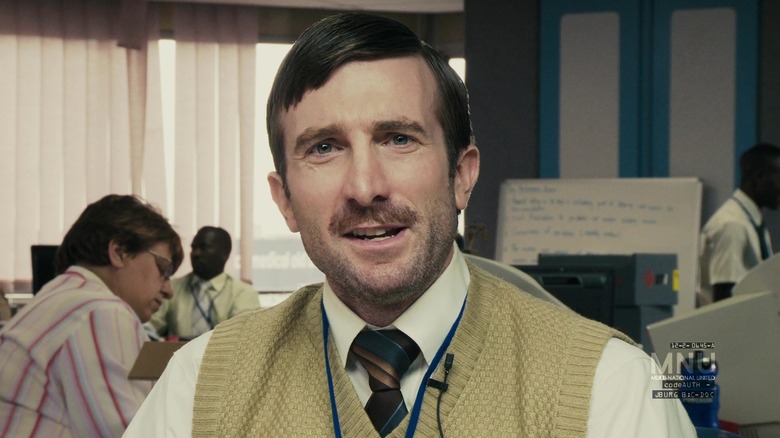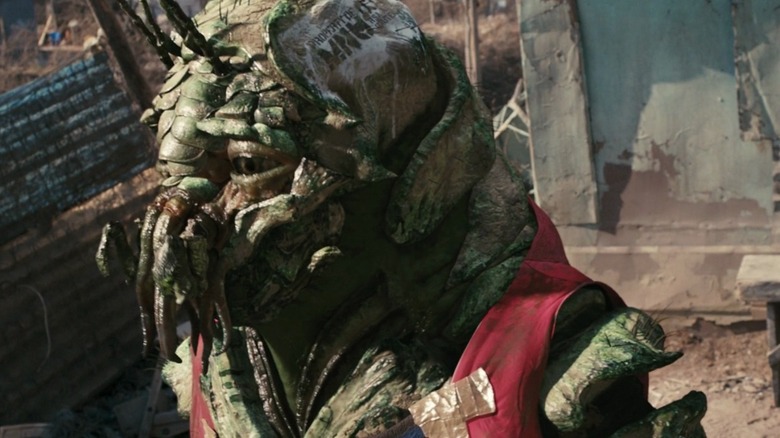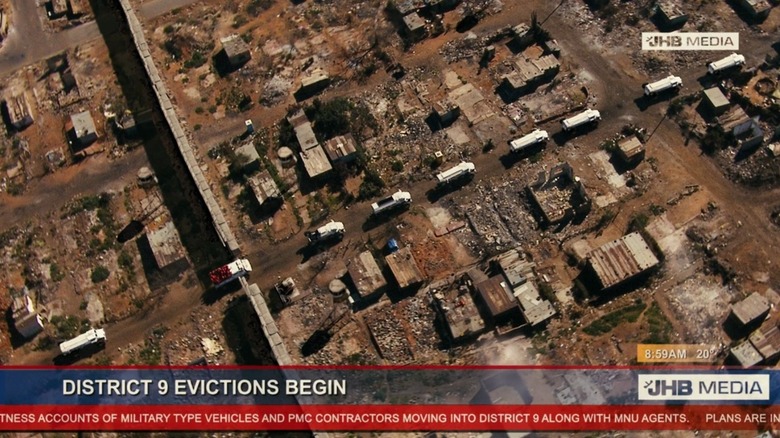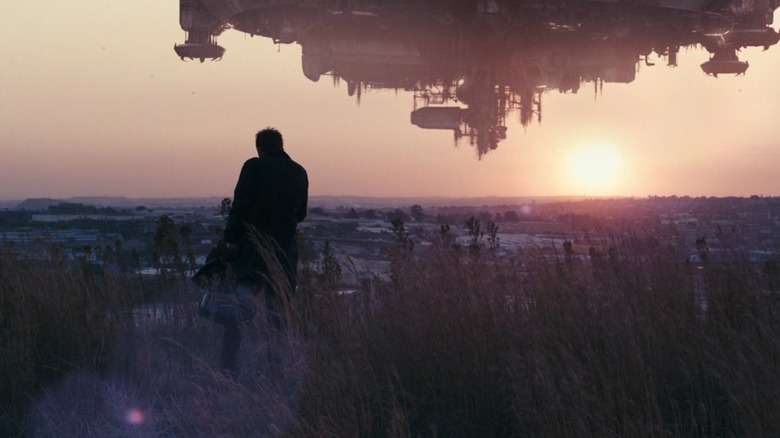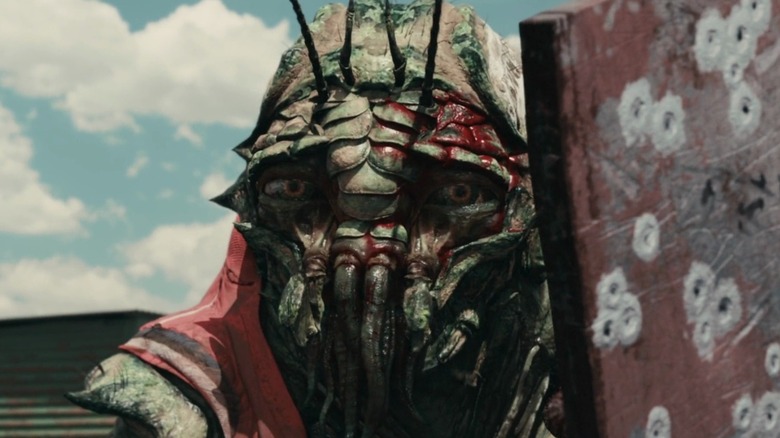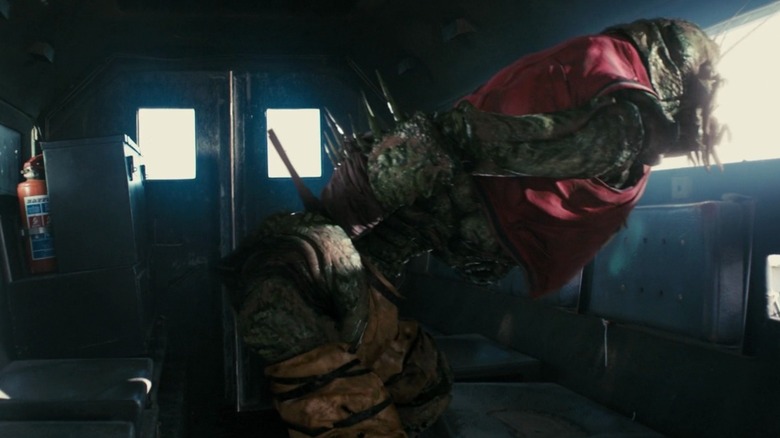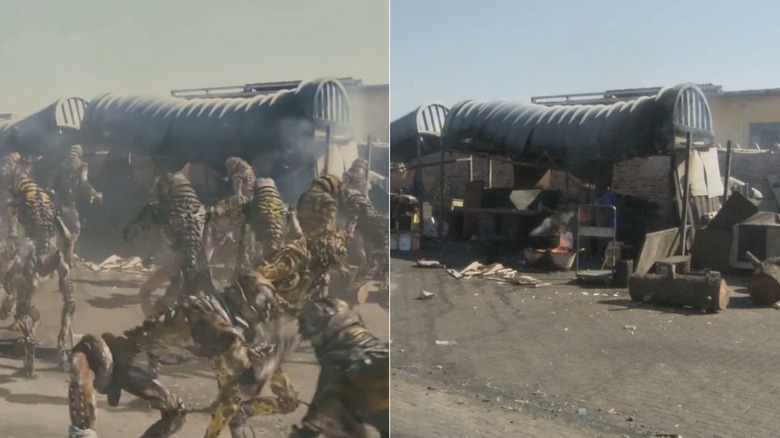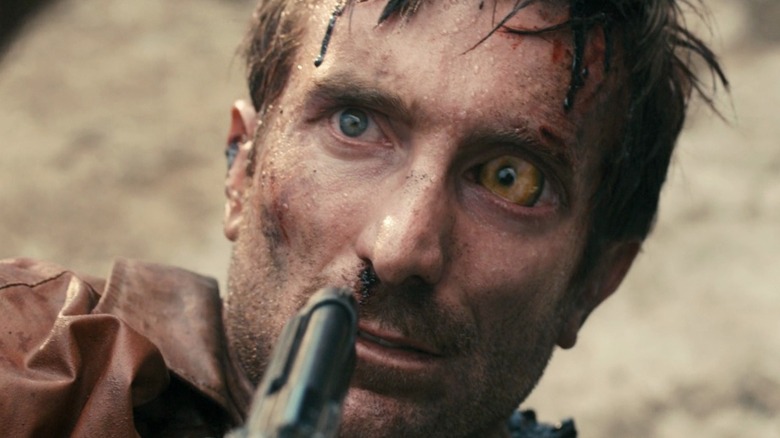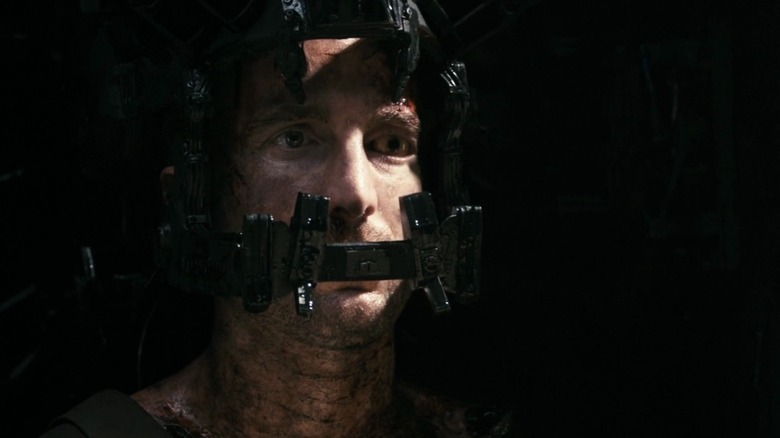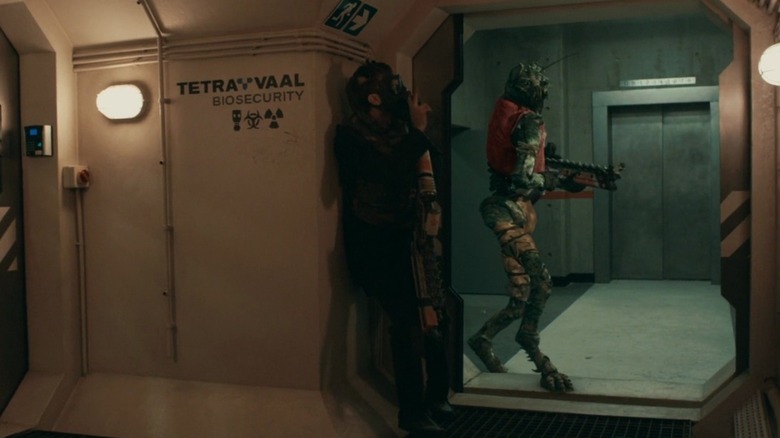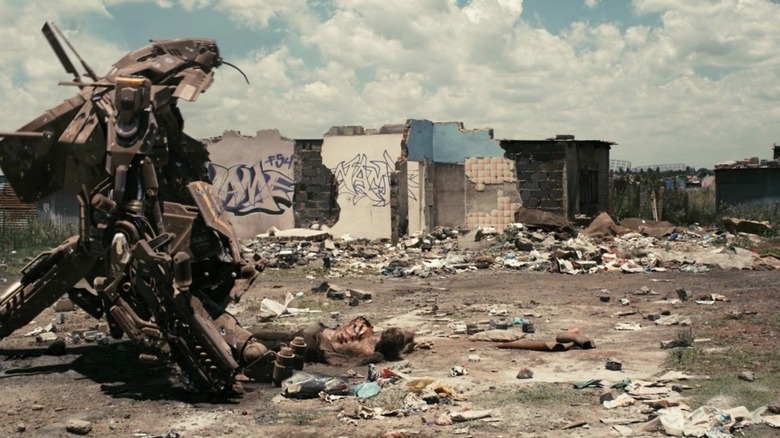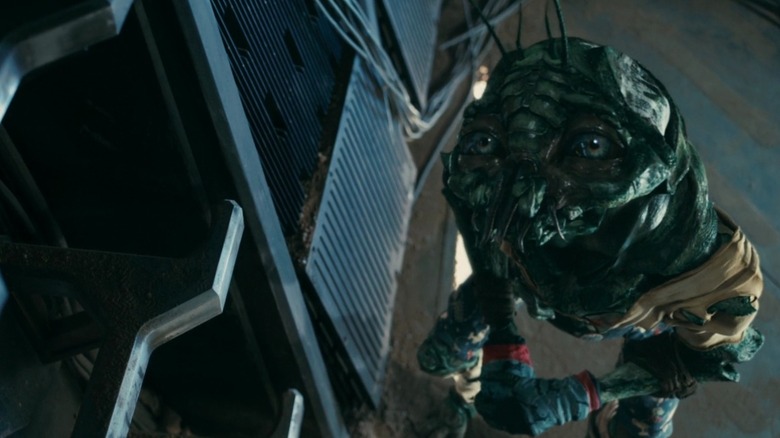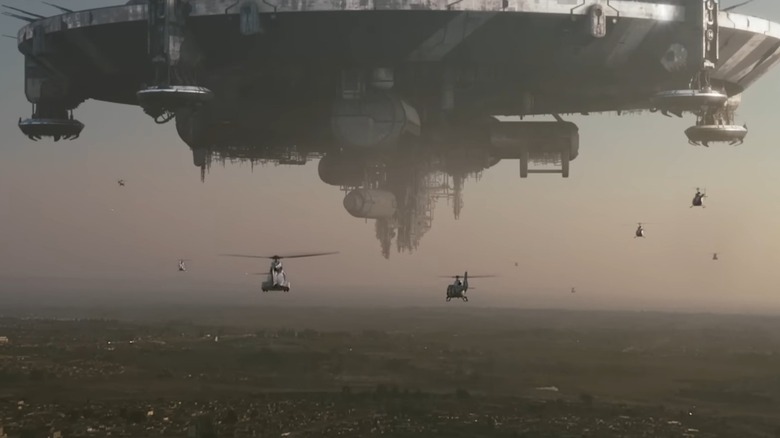What District 9 Looks Like Without Special Effects
When it was released in 2009, "District 9" was nothing short of mind-blowing. The movie told an original story that paired high sci-fi concepts with heartbreakingly grounded social commentary. It created incredibly memorable characters like Wikus the tragically transformed human and Christopher the alien refugee. There are so many things you only notice when you rewatch "District 9," and that is because the movie's world and the characters in it were crafted with incredible care.
Not for nothing, the movie earned upward of $200 million on a budget of just $30 million. That budget is especially astounding when you consider the amount of special effects it took to make the movie. Visual effects artists had to create an alien ship above Johannesburg, and they had to fill entire neighborhoods with aliens and make the most of advanced motion capture technology that was still in its infancy.
Fans are still wondering why we never got a sequel to "District 9," and many are still hoping that "District 10" will eventually become a reality. But while the ending of "District 9" leaves you hungry for more, the secrets behind the making of the film will leave you simply astonished. In its attempt to make a grounded sci-fi story, the movie pushed digital effects to their absolute limit, and without them "District 9" would look completely different. We take a peek behind the scenes to see what "District 9" could've looked like without special effects.
All the aliens are really just one person
"District 9" is impressive in plenty of different ways. It tells an incredible, original story, and — for the time at least — the movie really stretched the limits of what visual effects were capable of doing. What's even more impressive is that the movie was made for a figure that pales in comparison to the budgets for most major blockbusters.
So how do you create a fully fleshed-out alien species and introduce viewers to an entire society of alien refugees on a budget of just $30 million? Part of the secret behind "District 9" is that director Neill Blomkamp made careful use of all his resources. Everything that the movie needed, it got, and anything that was really just an unnecessary extra was cut. And it turns out that you don't actually need an army of actors to bring an alien civilization to life: you just need one and some visual effects trickery.
There are thousands of aliens in "District 9," and more than a handful of them have speaking lines or something important to do in the movie. The VFX artists deserve heaps of praise for creating so many unique creatures, but underneath all the technological mastery, every one of the aliens looks the same and Jason Koepp is the single actor who played every alien in the movie. Every time that Wikus (Sharlto Copley) interacts with a new resident of District 9, he's really just talking to Koepp. In fact, the only alien who isn't played by Koepp is the one played by Copley after he transforms.
Real homes were transformed into alien shelters
More than a decade after the film's debut, some of the visual effects in "District 9" are understandably starting to show their age. CGI has come a long way since 2009, but even though modern movies can create effects that are more realistic than the aliens in "District 9," Neill Blomkamp's movie still feels more real than a lot of things major studios are putting out. There are a few reasons for that, but one of the biggest is that "District 9" goes out of its way to blend visual effects into real locations.
The majority of the movie was shot on location in South Africa, which went a long way toward making the world of "District 9" come to life. Some of the most important VFX shots in the entire movie consist of more real components than computer-generated ones. The alien spaceship might have been created on a computer, but the filmmakers took actual shots of the city that it floats over and blended the two. By sliding the visual effects into the background of in-camera shots, "District 9" is able to dodge the poor aging that affects so many other movies from the 2000s.
It's not just the big important shots that were mostly created in real life. The aliens that live in District 9 are definitely computer-generated, but the homes that they live in are entirely real. The scenes set in District 9 itself were shot in the neighborhood of Soweto, and the homes that belonged to aliens in the movie actually belonged to real people. The living conditions of the aliens in the movie feel so real because they so closely mimic reality. Using a real deprived neighborhood also emphasizes the movie's timely themes regarding refugees and the great economic disparity that exists between rich and poor.
It was shot without green screens
When you're making a movie that's heavy on visual effects, green screens can be a lifesaver. Need to insert a character into a battle with tens of thousands of elves fighting a hundred thousand orcs? Use a green screen. Can't find actors and a camera crew willing to take a quick flight up to the moon? Use a green screen. Whatever the genre of the movie, green screens can simplify the visual effects process, but their legitimate benefits come with a cost.
To make green screens work, you have to plan shots or sometimes even entire scenes around their presence on set. When Neill Blomkamp made his plans for "District 9," he knew he needed to make the movie feel as grounded as possible. That's why, if you strip away all the effects, "District 9" looks just like any other movie to a point. Blomkamp didn't use green screens, and he summed up his reasoning in an interview with Wired, saying, "[It] makes it feel a little bit more real because you're not putting the visual effects up on a pedestal. They just happen to be there, and you just happen to be filming them."
The VFX artists working on "District 9" could have saved themselves countless hours of work if they'd insisted on using green screens, but the movie wouldn't feel nearly as realistic and believable as it does. By inserting all the VFX into real shots, "District 9" comes to life in a way few other movies do.
Motion capture helped create the aliens
We've gotten used to seeing motion capture technology used in superhero blockbusters and first-person shooters, but there was a time not all that long ago when mocap didn't dominate the entertainment industry. Back in 2009, the technology was still very much in its growth stage, and "District 9" helped prove just how useful mocap could be.
Multiple studios helped create the visual effects in "District 9," but Animatrik Film handled all of the motion capture work. Typically when shooting motion capture, all the actors are gathered in a studio and made to wear those distinctive mocap suits while they act out their scenes together. In addition to figuring out how to create the movie's mocap shots, Animatrik also had to develop an entirely different filming process.
"District 9" was primarily shot in South Africa, but Animatrik did all of the mocap work at its headquarters in Vancouver. The company was able to borrow some actors for additional days of shooting, but it essentially had to recreate the South African scenes in its studio, and then insert the mocap footage back into the original scenes after the fact. Altogether the mocap work was a bit more complicated than it is for most other projects, but the end result proves that the hard work more than paid off.
Stilts became alien legs
When it comes to making effective use of motion capture, some stories have it easier than others. For stories that follow human, or at least human-adjacent characters, it doesn't take much to transform actors into their computer-generated counterparts. Even a character like Gollum is human enough that a computer was able to translate Andy Serkis' movements into the images it needed for the "Lord of the Rings" movies.
Using mocap to create the prawns in "District 9" was a little more complicated. The movie's aliens are about as far from human beings as you can get. They're significantly larger than an average person, and other than having four limbs, their bodies don't share much in common with human physiology. So how does a human actor in a mocap suit go about moving like one of the movie's imposing aliens?
While shooting all the mocap footage, Animatrik came up with an ingenious way to make its human actors look and move more like the creatures in "District 9." Because the prawns have extremely long legs with an extra joint, Animatrik strapped stilts on some of its actors while they moved around the studio. The stilts let the actors move a bit more like the aliens they were portraying, which made transferring their motions into the computer that much easier.
Without effects, some of the scenes are just empty
Motion capture managed to create the main alien characters in "District 9," but it wasn't the only technique that helped bring the eponymous refugee camp to life. For many of the wide shots that feature huge crowds of aliens moving through the street, good old-fashioned CGI was the go-to tool. It's easier to create a few dozen aliens as digital inserts than it is to film mocap with a massive crowd, so Image Engine got to work constructing some CGI shots.
Despite having frequent shots that lean heavily on CGI, "District 9" manages to never stop feeling immersive. The mixture of real locations, shaky camera footage, and environmental effects like dust and smoke all help sell the movie's reality. The special combination was the real key to the movie's success, but it also means that when you strip away all the special effects, "District 9" doesn't look like other sci-fi movies. Without special effects, so many other productions are little more than a green screen with people standing around in funny skintight suits. But because so much of "District 9" was shot using real locations, removing the special effects layer leaves it looking like documentary footage filmed by someone who perhaps developed a fascination with barren urban landscapes. Many of the shots without special effects are just empty scenes that artists filled with aliens after the fact.
Makeup created some stunning transformations
CGI and motion capture helped make the aliens in "District 9" a reality, but they aren't the be-all and end-all of visual effects. People have been making movies with otherworldly images since long before digital technology really took hold, and sometimes there's just no replacement for classic techniques. Even while "District 9" was pushing the capabilities of digital effects to the next level, the movie was also relying on makeup for some of its most impressive visuals.
The film's protagonist, Wikus, does not have an easy time of things. He's just a regular person struggling to do the nearly impossible job of managing the alien refugee crisis and setting up District 9. However, his situation goes from bad to worse when an accidental encounter with some alien fuel starts changing his body into one of the prawns.
Wikus' transformation is tragic, but it's also something you can't tear your eyes away from. The grotesque changes to his body are engrossing because they look so real, and to a certain extent, they are. Makeup artists bridged the gap between real-life humans and CGI aliens by transforming parts of Sharlto Copley's body into an alien. Wikus' transformation isn't just a perfect blend of reality and movie magic: It's also one of the best visual effects in "District 9."
The props used very few digital effects
Aliens are great, but what really gets sci-fi fans excited is all the futuristic tech, and there's no shortage of high-tech gadgetry in "District 9." From alien fuel canisters and mining gear to spaceships and metal exo-suits, the movie really has it all. When it came to creating all the different bits of gear in the movie, the filmmakers took a slightly different approach than creating the aliens.
The guns and machinery on display in "District 9" are all actual props that were designed and built by Weta Workshop – the team who also worked on "Lord of the Rings." The artists there tried to get creative with their approach to the movie's weapons and came up with a handful of futuristic tools that could double as guns. With a collection of military equipment and threatening-looking tools constructed, they purposefully dirtied up the props to make them fit in with the rest of the movie's surroundings.
The well-thought-out designs come through in the movie and help make all the props feel more like important parts of the world than just set dressing. Having real props also lends some weight to what the human actors are doing on screen, and the fact that the humans and the aliens all interact with the props strengthens the overall realism of the story once again.
The aliens could have been people in suits
"District 9" goes out of its way to use practical effects wherever it can. Scenes are shot in real locations. The guns that the characters handle are all real. Even Wikus' inhuman transformation was largely created practically with makeup. Considering all that reliance on practical effects, it makes sense to wonder why Neill Blomkamp didn't want to create the aliens practically, too. According to the director, that was a real consideration early in the process of making the movie.
In an interview with Mark Walters, Blomkamp explained that he didn't just think about using alien suits for the prawns in "District 9," he actually had some made. The suits were designed and built by Weta Workshop — which handled all of the movie's props – and Blomkamp said the hope was that using suits would help the movie stay within its budget.
Unfortunately, almost as soon as Blomkamp got his hands on the suits, he knew that they weren't going to work. "Weta's brilliant, but it's just, if you put a human in a suit, it's gonna look like a guy in a suit," he said. They tried shooting some scenes with the suits, but they quickly realized that digital effects were going to be needed to create the desired effect.
The shot backgrounds are often faked
The shaky camera footage that helps make "District 9" feel so real created an absolute nightmare for some of the visual effects artists working on the film. Without the help of a steady frame, inserting the aliens from the motion capture footage became significantly more difficult. There was no stable point of reference to use for the background of the shot and no green screen to help smooth over the digital insert.
If the VFX artists used a normal process, the background behind any digitally inserted alien wouldn't actually line up with the location shot around it. To fix that, artists had to draw in the backgrounds themselves, and then sync their own drawings to the shaky footage from the camera. They went frame by frame through countless shots to make sure that the aliens fit smoothly into the rest of the movie. It was some of the most labor-intensive effects work in the entire movie, and most people who watch "District 9" will never even notice it.
A million aliens were digitally created
Image Engine is the studio behind most of the CGI in "District 9." The company grew rapidly as it worked on the movie, and there's one shot in particular that represents the entire time period for animation supervisor Steve Nichols. "They originally called it the '100-alien shot,'" Nichols told Studio Daily. "When [director Neill Blomkamp] started talking about how many aliens he really wanted, it became the '1,000,000-alien shot.'"
The shot in question comes near the beginning of the movie and shows the bodies of countless aliens resting in pods inside the massive saucer floating above Johannesburg. The moment establishes the scale of the refugee crisis and sets up the overarching conflict of the movie, and it's one of the few times the entire screen is dedicated to CGI. Image Engine created it from the ground up, using some new software and processes the company developed in the process.
In the end the shot worked perfectly for the movie. Blomkamp thought so, too, but his compliment to the studio wasn't what VFX Supervisor Dan Kaufman expected. "[He] sent me an email after the movie was over saying, 'Oh, by the way, I ran that shot through a VHS player. It works really well in the movie,'" Kaufman said. "I emailed him back saying, 'Well, whatever works – but I won't tell the compositor that!'"
UN helicopters became government assets
Despite all the sci-fi concepts in the movie, "District 9" goes to great lengths to ground itself in reality, but sometimes the reality that sneaks into the movie isn't what you'd expect. There are multiple shots throughout the film that show military vehicles interacting with the aliens in some capacity. Helicopters fly toward the ship above Johannesburg, and tanks roll through the district.
At this point, it will probably surprise no one to know that those vehicles weren't computer-generated. Of course, Neill Blomkamp insisted on tracking down real helicopters and tanks for the movie — especially considering that renting a helicopter might actually be cheaper than digitally creating one. That said, Blomkamp didn't get the gear he really wanted, and the vehicles that appear in the movie came from an unexpected source.
In 2009 Blomkamp told Boston.com that he'd envisioned using real tanks from the apartheid era because that model "is hands down the craziest-looking vehicle known to man." Blomkamp's vision didn't become a reality. His plans for the tanks fell through, and the South African government told him no on the helicopters, too. Instead, Blomkamp managed to borrow helicopters from the United Nations, of all places. The helicopters were waiting to fly from Sudan to South Africa, and the director managed to snag them for a few key shots in the movie. The aliens might all be made with special effects, but the human tech in this case is genuine.
